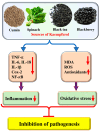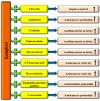Pharmacological Potential of Kaempferol, a Flavonoid in the Management of Pathogenesis via Modulation of Inflammation and Other Biological Activities
- PMID: 38731498
- PMCID: PMC11085411
- DOI: 10.3390/molecules29092007
Pharmacological Potential of Kaempferol, a Flavonoid in the Management of Pathogenesis via Modulation of Inflammation and Other Biological Activities
Abstract
Natural products and their bioactive compounds have been used for centuries to prevent and treat numerous diseases. Kaempferol, a flavonoid found in vegetables, fruits, and spices, is recognized for its various beneficial properties, including its antioxidant and anti-inflammatory potential. This molecule has been identified as a potential means of managing different pathogenesis due to its capability to manage various biological activities. Moreover, this compound has a wide range of health-promoting benefits, such as cardioprotective, neuroprotective, hepatoprotective, and anti-diabetic, and has a role in maintaining eye, skin, and respiratory system health. Furthermore, it can also inhibit tumor growth and modulate various cell-signaling pathways. In vivo and in vitro studies have demonstrated that this compound has been shown to increase efficacy when combined with other natural products or drugs. In addition, kaempferol-based nano-formulations are more effective than kaempferol treatment alone. This review aims to provide detailed information about the sources of this compound, its bioavailability, and its role in various pathogenesis. Although there is promising evidence for its ability to manage diseases, it is crucial to conduct further investigations to know its toxicity, safety aspects, and mechanism of action in health management.
Keywords: anti-diabetic effect; cancer therapy; health-promoting effects; inflammation; kaempferol; oxidative stress.
Conflict of interest statement
The authors declare no conflict of interest.
Figures









References
-
- Yu R., Zhong J., Zhou Q., Ren W., Liu Z., Bian Y. Kaempferol prevents angiogenesis of rat intestinal microvascular endothelial cells induced by LPS and TNF-α via inhibiting VEGF/Akt/p38 signaling pathways and maintaining gut-vascular barrier integrity. Chem. Biol. Interact. 2022;366:110135. doi: 10.1016/j.cbi.2022.110135. - DOI - PubMed
-
- Sekiguchi A., Motegi S.-I., Fujiwara C., Yamazaki S., Inoue Y., Uchiyama A., Akai R., Iwawaki T., Ishikawa O. Inhibitory effect of kaempferol on skin fibrosis in systemic sclerosis by the suppression of oxidative stress. J. Dermatol. Sci. 2019;96:8–17. doi: 10.1016/j.jdermsci.2019.08.004. - DOI - PubMed
Publication types
MeSH terms
Substances
LinkOut - more resources
Full Text Sources

